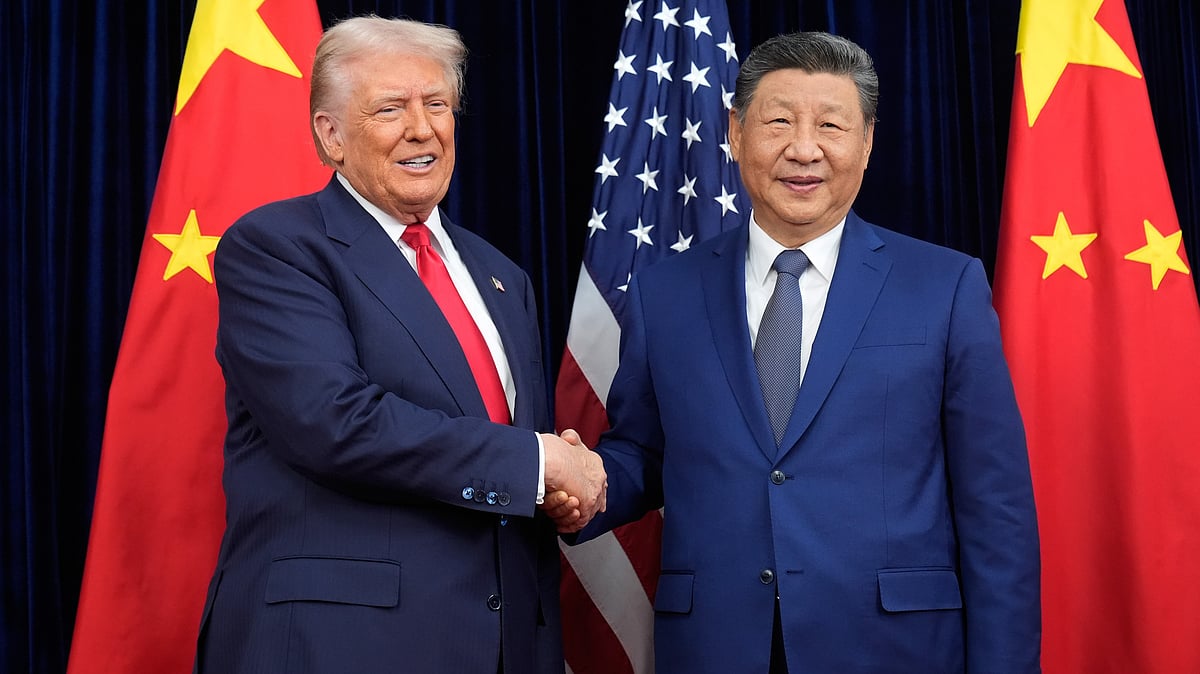World
Trump, Xi agree to cut tariffs, cooperate on fentanyl crackdown
US President hails ‘amazing meeting’ in Busan as leaders pledge to ease trade tensions and boost agricultural and energy ties

US President Donald Trump announced on Thursday that he and Chinese President Xi Jinping had agreed to reduce tariffs on Chinese goods in return for Beijing’s commitment to curb the illicit fentanyl trade, resume US soybean purchases, and maintain rare earth exports.
Among Washington’s major trading partners, only Brazil and India continue to face elevated tariffs.
The two leaders met face-to-face in the South Korean city of Busan, marking their first direct talks since 2019. The meeting concluded Trump’s whirlwind Asia tour, during which he also highlighted progress in trade discussions with South Korea, Japan, and several Southeast Asian nations.
“It was an amazing meeting,” Trump told reporters aboard Air Force One after departing South Korea, rating the talks “a 12 out of 10”.
According to Trump, tariffs on Chinese imports will be lowered to 47 per cent from 57 per cent, achieved by cutting in half to 10 per cent the levies applied to trade in fentanyl precursor chemicals. Xi, he added, had pledged to work “very hard to stop the flow” of fentanyl, a potent synthetic opioid that remains the leading cause of overdose deaths in the United States.
China also agreed to suspend recently announced export controls on rare earth elements — materials crucial for vehicles, aircraft, and weapons manufacturing — which had been viewed as one of Beijing’s most powerful tools in its trade confrontation with Washington. The Chinese commerce ministry said the suspension would last one year.
In a statement, the ministry confirmed that both countries had reached a consensus on expanding agricultural trade and would seek to resolve issues related to the short-video app TikTok, which Trump wants brought under US ownership.
Published: undefined
Markets react cautiously to signs of thaw
Global markets responded with restraint to the apparent easing of trade tensions, with major Asian indices and European futures swinging between gains and losses. China’s Shanghai Composite Index slipped from a decade high, while US soybean futures weakened.
“The market’s response has been more cautious than President Trump’s enthusiastic characterisation of the meeting,” said Besa Deda, chief economist at advisory firm William Buck in Sydney, as reported by Reuters.
In the run-up to the meeting, stock markets from New York to Tokyo had hit record highs amid expectations of a breakthrough in the protracted trade dispute between the world’s two largest economies, which has disrupted supply chains and dented global business confidence.
Trump had repeatedly expressed optimism about reaching an understanding with Xi after US negotiators said they had outlined a framework to avert 100 per cent tariffs on Chinese goods and defer China’s planned restrictions on rare earth exports.
The cordial meeting between the two leaders, held at a South Korean air base on the sidelines of the Asia-Pacific Economic Cooperation (APEC) summit, lasted over 90 minutes.
‘Friction is normal,’ says Xi
At the start of the meeting, Xi told Trump — through a translator — that occasional friction between the two nations was “normal”. He added that China’s “development and rejuvenation are not incompatible with President Trump’s goal of ‘Making America Great Again’.”
Both sides also agreed to suspend reciprocal port fees on shipping, part of a broader effort to ease tensions in shipbuilding and logistics.
Published: undefined
Trump later wrote on Truth Social that China would begin purchasing US energy, hinting at a major deal linked to a proposed $44 billion liquefied natural gas pipeline in Alaska.
The White House indicated it hopes the Busan meeting will be the first in a series of summits between the two leaders. Trump said he planned to visit China in April, followed by Xi’s reciprocal visit to the United States later in the year.
Chinese state media depicted the talks as a success for Xi’s leadership, with the official Xinhua news agency quoting him as saying: “We have the confidence and capability to navigate all kinds of risks and challenges.”
Trade truce but lingering disputes remain
The agreement effectively restores bilateral relations to their state before Trump’s 'Liberation Day' initiative in April reignited a cycle of retaliatory measures. Analysts, however, cautioned that the accord may represent only a temporary truce in a trade conflict whose root causes remain unresolved.
Trump said he had not discussed Nvidia’s advanced Blackwell chip with Xi — a setback for the semiconductor firm’s efforts to sustain its presence in China’s $50 billion artificial intelligence market.
He also confirmed that the sensitive issue of Taiwan — claimed by Beijing but regarded by Washington as a key partner — did not arise during the discussions.
Shortly before the meeting, Trump ordered the US military to resume nuclear weapons testing after a 33-year pause, citing the expanding arsenals of Russia and China. In response, China’s foreign ministry said it hoped the US would adhere to its moratorium on such tests.
With agency inputs
Published: undefined
Follow us on: Facebook, Twitter, Google News, Instagram
Join our official telegram channel (@nationalherald) and stay updated with the latest headlines
Published: undefined